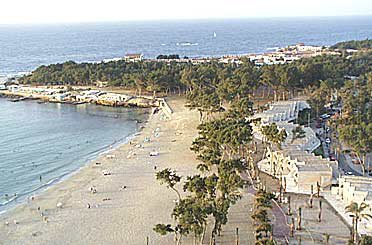 The
Alexandria Coast: one of the best beaches of
the world for swimming with it's sandy beach and clear water
with a reasonable distance to swim through like a swimming pool
area. Alexandria beach is the north edge of Egypt beginning from
Abu Keir in the East to the Ras-Eltin in the west, then it is
now extended on the west side to reach the Marsa Matrouh
Governorate of Al-Alamein.
The
Alexandria Coast: one of the best beaches of
the world for swimming with it's sandy beach and clear water
with a reasonable distance to swim through like a swimming pool
area. Alexandria beach is the north edge of Egypt beginning from
Abu Keir in the East to the Ras-Eltin in the west, then it is
now extended on the west side to reach the Marsa Matrouh
Governorate of Al-Alamein.
The
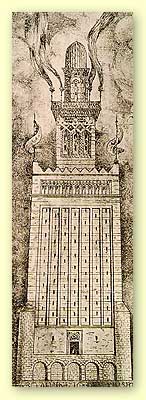 Alexandria
Light House (One of the 7th world wounders):
Alexandria
Light House (One of the 7th world wounders):
So impressive was ancient Egypt's
building efforts over the pharaonic period that it commanded two
wonders of the ancient world. One, the Great Pyramid of Giza,
was built near the beginning of Egyptian history, while the
second, Seventh Wonder was mostly built by one of Egypt's last
pharaohs, Ptolemy I Sorter, though he died prior to its
completion. While the first still stands, the latter was
destroyed, almost certainly by an earthquake. This was Pharos
Lighthouse of Alexandria, which of the vanished wonders of the
ancient world, was the last built and the last to remain
standing. Pharos Lighthouse
stood on the eastern point of Pharos Island some distance from
the city center of Alexandria. The light house where destroyed
many times and being rebuilt by many Egyptian , Roman and
Islamic kings through the history of Alexandria, the unique
choice of it's place give the ability to be seen from 100 miles
away of Alexandria Beach, it was really a wonderful work.
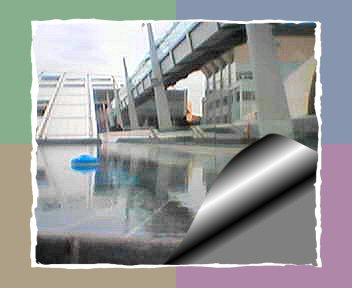 The
Alexandria Bibliotheca: the biggest, the
modernist and Oldest library of the world since the Pharaohs
established it, was burned by the Roman (Caesar and Anthony)
during the Queen Cleopatra period before Christmas and
re-established by the Egyptian Government 5 years ago with
cooperation with UNESCO, French Government and many other
countries. Alexandria Bibliotheca is the evidence for Pharaonic
scientific thinking and their great civilization.
The
Alexandria Bibliotheca: the biggest, the
modernist and Oldest library of the world since the Pharaohs
established it, was burned by the Roman (Caesar and Anthony)
during the Queen Cleopatra period before Christmas and
re-established by the Egyptian Government 5 years ago with
cooperation with UNESCO, French Government and many other
countries. Alexandria Bibliotheca is the evidence for Pharaonic
scientific thinking and their great civilization.
The
Roman Theater: Over 30 years of excavation have
uncovered many Roman remains including this well-preserved
theatre with galleries, sections of mosaic-f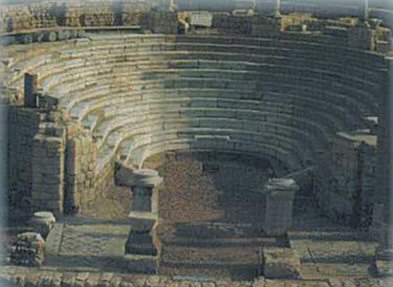 looring,
and marble seats for up to 800 spectators. In Ptolemaic times,
this area was the Park of Pan and a pleasure garden. The theater
at one point may had been roofed over to serve as an Odeon for
musical performances. Inscriptions suggest that it was sometimes
also used for wrestling contests. The theatre stood with
thirteen semi-circular tiers of white marble that was imported
from Europe. Its columns are of green marble imported from Asia
Minor, and red granite imported from Aswan. The wings on either
side of the stage are decorated with geometric mosaic paving.
The dusty walls of the trenches, from digging in the northeast
side of the Odeon, are layered with extraordinary amounts of
potsherds. Going down out of the Kom, you can see the
substantial arches and walls in stone, the brick of the Roman
baths, and the remains of Roman houses..
looring,
and marble seats for up to 800 spectators. In Ptolemaic times,
this area was the Park of Pan and a pleasure garden. The theater
at one point may had been roofed over to serve as an Odeon for
musical performances. Inscriptions suggest that it was sometimes
also used for wrestling contests. The theatre stood with
thirteen semi-circular tiers of white marble that was imported
from Europe. Its columns are of green marble imported from Asia
Minor, and red granite imported from Aswan. The wings on either
side of the stage are decorated with geometric mosaic paving.
The dusty walls of the trenches, from digging in the northeast
side of the Odeon, are layered with extraordinary amounts of
potsherds. Going down out of the Kom, you can see the
substantial arches and walls in stone, the brick of the Roman
baths, and the remains of Roman houses..
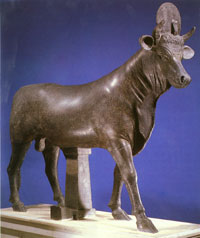 The
Roman Museum: At the City center the museum was
first built in 1892 as a small building located on Horreya Road.
In 1895 it was transferred to the present site near Gamal Abdul
Nasser Road. It started with eleven galleries, and has been
gradually enlarged in later renovation stages. The 25th gallery
was inaugurated in 1984. It contains a very big variety of coins
from different countries, chronologically arranged, and dating
back from 630 BC to the Ottoman period in the 19th century. The
collection, which covers the period from the 3rd century BC to
the 7th century AD, is a fascinating record of civilization in
the process of change as religions merged and society evolved.
The museum contains hundreds of precious antiques. We will
describe the most valuable ones or the best areas in the museum.
Honestly, I have been to that museum more than five times and I
still would love to go again.
The
Roman Museum: At the City center the museum was
first built in 1892 as a small building located on Horreya Road.
In 1895 it was transferred to the present site near Gamal Abdul
Nasser Road. It started with eleven galleries, and has been
gradually enlarged in later renovation stages. The 25th gallery
was inaugurated in 1984. It contains a very big variety of coins
from different countries, chronologically arranged, and dating
back from 630 BC to the Ottoman period in the 19th century. The
collection, which covers the period from the 3rd century BC to
the 7th century AD, is a fascinating record of civilization in
the process of change as religions merged and society evolved.
The museum contains hundreds of precious antiques. We will
describe the most valuable ones or the best areas in the museum.
Honestly, I have been to that museum more than five times and I
still would love to go again.
The
Castle of Sultan Ashraf Quietbai: Ras El-tin
point was protecting Alexandria from enemy's attacks coming from
the Mediterranean Sea Side, another period of the Egyptian
history. This section of Alexandria is known to us more from
books then what we may actually see in the area. Where the
Pharos Lighthouse once stood, is now occupied by the Fort of
Quit Bay (1) out on the area that circles up around the top of
Eastern Harbor forming the eastern section of the top of the T.
Heading south from the Fort of Quit Bay, we come to the stunning
Abu El-Abbas Mosque (2). West of this is the Anfushi Tombs (3),
some of the oldest in Alexandria and well worth a visit.
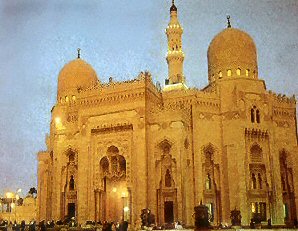 The
Grand Mosques of El-Morsi Abu EL-Abbas and Imam Boseiry:
becomes one of the most wanted visits in Alexandria where the
tombs of these two persons whom were learning people Islamic
religion and had been famous over the Islamic history.
The
Grand Mosques of El-Morsi Abu EL-Abbas and Imam Boseiry:
becomes one of the most wanted visits in Alexandria where the
tombs of these two persons whom were learning people Islamic
religion and had been famous over the Islamic history.
AL-Montazah
Palace: This 115 acre complex is surrounded by
great walls from the south, east and west, and with the beach on
its north side. This area used to belong to the Mohamed Ali
family, that ruled Egypt from the mid 19th century until 1952.
The construction was started in 1892 by King Abbas II, who built
a large palace inside the complex called the Salamlek. In 1932,
King Fuad built a larger palace and called it the Haramlik. His
son, King Farouk, built a bridge to the sea to act as a water
front. The rest of the 115 acres is nothing but beautiful
gardens. Palm trees and gazelles cover the area. This is a
wonderful spot to enjoy the beauty of Alexandria.
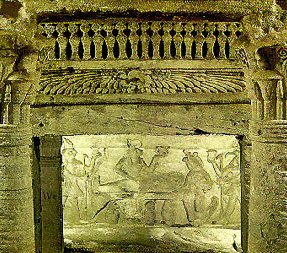 Kom
El-Shokafa:
Kom
El-Shokafa:
the
Catacomb: These tombs were tunneled into the bedrock in the age
of the Antonine emperors (2nd century A.D.) for a single wealthy
family still practicing the ancient religion. As a privately
financed project, it is an engineering feat of some magnitude.
These tombs represent the last existing major construction for
the sake of the old Egyptian religion. They are alone worth the
trip to
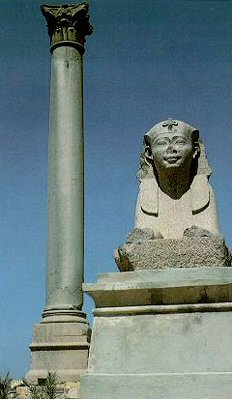 Alexandria.
Alexandria.
The
Pompey's Pillar: An approximately 25m red Aswan
granite column with a circumference of 9m, was constructed in
honor of the Emperor Diocletian. Originally from the temple of
the Serapis, it was once a magnificent structure rivaling the
Soma and the Caesareum. Nearby are subterranean galleries where
sacred Apis bulls were buried, and three sphinxes. After his
defeat by Julius Caesar in the civil war, Pompey fled to Egypt
where he was murdered in 48 BC; mediaeval travelers later
believed he must be buried here, and that the capital atop the
corner served as a container for his head. In fact, the pillar
was raised in honor of Diocletian at the very end of the 4th
century. Diocletian captured Alexandria after it had been under
siege. The Arabs called it "Amoud el-Sawari", Column of the
Horsemen. The Pillar is the tallest ancient monument in
Alexandria.
